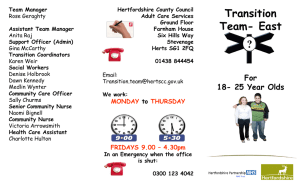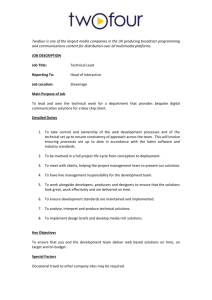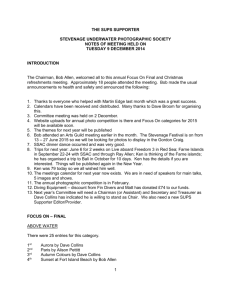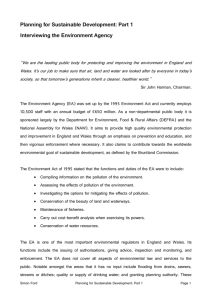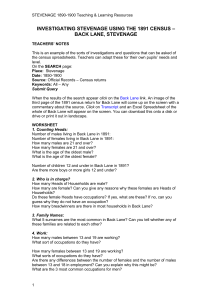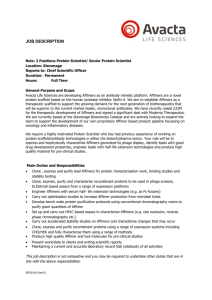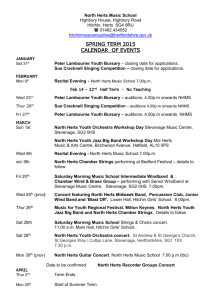stintronotes - Hertfordshire Grid for Learning
advertisement
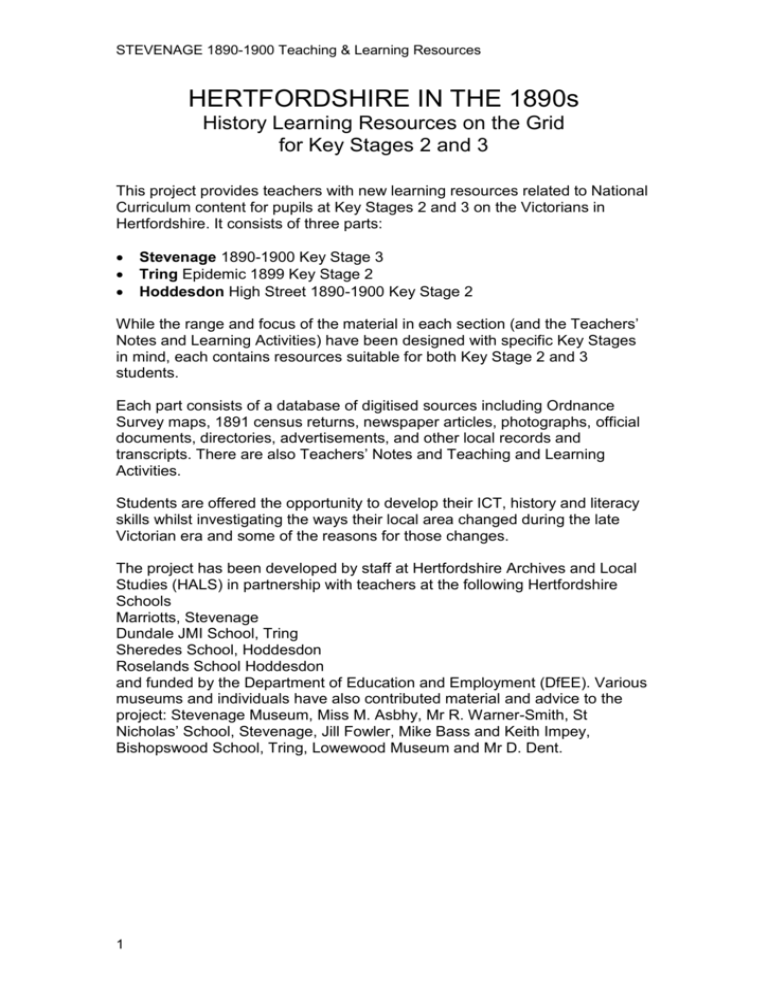
STEVENAGE 1890-1900 Teaching & Learning Resources HERTFORDSHIRE IN THE 1890s History Learning Resources on the Grid for Key Stages 2 and 3 This project provides teachers with new learning resources related to National Curriculum content for pupils at Key Stages 2 and 3 on the Victorians in Hertfordshire. It consists of three parts: Stevenage 1890-1900 Key Stage 3 Tring Epidemic 1899 Key Stage 2 Hoddesdon High Street 1890-1900 Key Stage 2 While the range and focus of the material in each section (and the Teachers’ Notes and Learning Activities) have been designed with specific Key Stages in mind, each contains resources suitable for both Key Stage 2 and 3 students. Each part consists of a database of digitised sources including Ordnance Survey maps, 1891 census returns, newspaper articles, photographs, official documents, directories, advertisements, and other local records and transcripts. There are also Teachers’ Notes and Teaching and Learning Activities. Students are offered the opportunity to develop their ICT, history and literacy skills whilst investigating the ways their local area changed during the late Victorian era and some of the reasons for those changes. The project has been developed by staff at Hertfordshire Archives and Local Studies (HALS) in partnership with teachers at the following Hertfordshire Schools Marriotts, Stevenage Dundale JMI School, Tring Sheredes School, Hoddesdon Roselands School Hoddesdon and funded by the Department of Education and Employment (DfEE). Various museums and individuals have also contributed material and advice to the project: Stevenage Museum, Miss M. Asbhy, Mr R. Warner-Smith, St Nicholas’ School, Stevenage, Jill Fowler, Mike Bass and Keith Impey, Bishopswood School, Tring, Lowewood Museum and Mr D. Dent. 1 STEVENAGE 1890-1900 Teaching & Learning Resources STEVENAGE 1890-1900 TEACHERS’ NOTES Key Stage 3 - Britain 1750-1900 National Curriculum Study Unit 3: 2. Studies in Depth: the development of legislation to improve living and working conditions industrialisation in a local area changes in agriculture & rural life 7. Across the key stage, pupils should be given opportunities to study aspects of the past in outline, in depth and through a local context. Pupils should be given opportunities to apply and develop their ICT capability through the use of ICT to support their learning in history. Investigation: What was life like for people in Stevenage at the end of the 19th century and how had political, industrial and rural changes affected people’s lives? Stevenage 1890-1900 consists of a database of about 200 sources from a variety of documents. Each source has a unique commentary and these can be printed out. There are also guides to using the database, to searching and filtering the Excel spreadsheets of the 1891 Census and Teaching and Learning Resources and Ideas. After a time there will also be examples online of teachers’ and pupils’ work based on this part of the project. If you would like to contribute to this section please contact Hertfordshire Archives and Local Studies (HALS). BEFORE YOU START: Become familiar with the content and structure of the database yourself before you use it with a class. You may wish to specifically select certain sources and direct your pupils to these or you may wish to design your own database search activities. The level of guidance required to use the database will obviously depend on your students, their range of abilities and ICT competence. The database has been designed to support a much broader subject and time range than the Victorians and therefore the search categories tend to be general rather than specific. There are several Activity Sheets that you can use with your students or better still, use as the basis for designing your own investigation and tasks. If you have been studying another local area in Britain then the material on 2 STEVENAGE 1890-1900 Teaching & Learning Resources Stevenage may provide some interesting comparisons. You can also mix the sources (for example, the Census Returns or Medical Officers of Health Annual Statistics) on Stevenage, Tring and Hoddesdon to provide a wider context for comparison. You can use the material online or print out parts that you wish to focus on. IDEAS TO GET YOU STARTED: A. CENSUS – whole class or small group activity. You can allocate an area of the census to each small group or pair eg Back Lane, Albert St., Letchmore Green, each side of High St. Give them the description of the area they are looking at from the census and also the ordnance survey map. 1. What can the census tell us about families and life in Stevenage in 1891? [Database & spreadsheet work using census on Excel] Size of families Numbers of people per house Size of houses Occupations – rural/industrial, men/women, family patterns Numbers of breadwinners per household Differences between streets in Stevenage – Back Lane/London Rd eg. Make-up of households – servants, family composition, boarders and lodgers Age distribution In-migration within Hertfordshire and from other counties Establishing and testing markers for identifying wealth and poverty B. Database Investigation: It would be possible to use groups for the following: 1. Was Stevenage a healthy place in which to live 1890-1900? [Health – sanitation, water and sewerage provision, epidemics (Annual Reports of District Medical Officers, Local Board of Health minutes, School Log Books, Burial records)] What diseases did people in Stevenage suffer from? What caused these? How did people try to make Stevenage a healthier place? Were they successful? How did Stevenage compare with other urban districts in Hertfordshire? How did Stevenage compare with rural districts in Hertfordshire? Would you expect rural or urban areas to be healthier at the end of the nineteenth century? Look at the records for Hertfordshire to test your ideas. Were rural or urban areas healthier in Hertfordshire? What did people die from in Stevenage 1890-1900? Using Burial Records can you find out what was the average age of death in 1891? Can you see any patterns in the deaths? How did disease and illness affect people’s lives? What steps did working people take to try to lessen the effects of disease and illness on their lives? 3 STEVENAGE 1890-1900 Teaching & Learning Resources What happened to people who could not work or support themselves? 2. How important was education to people in Stevenage 1890-1900? [school attendance, leaving age (School Attendance Committee minutes, Board of Guardians, newspaper articles, parish magazine, School Log books) Did everyone receive an education? Was it free or did it have to be paid for? What sorts of problems did the education authorities have in Stevenage? Did everyone in Stevenage consider education and schooling important? What measures did the educational authorities take to ensure that children attended school? What reasons can you find for why children did not attend school? What happened to children who did not attend school? If working men in Britain were earning about £1 - £1/5/- per week, then what comment can you make about the fines imposed on parents whose children did not attend school? How effective were the measures taken to make sure children attended school? 3. What sorts of goods and services were available to people in Stevenage 1890-1900? [Trade directories, ads, photographs] What could you buy in Stevenage and what services were provided? Can you find evidence of goods coming from outside Stevenage? What sorts of foods were available in Stevenage? How did people shop? 4. What did people in Stevenage do when they were not at work? What did men, women and children do in any spare time they might have had? Were there differences between men and women’s leisure interests? Who provided leisure activities and facilities at the end of the 19th century? Were leisure activities just for fun or was there another purpose? To what extent were leisure activities community events? What was the role of the Church in people’s lives at this time? What other events occurred over a year which people looked forward to? 5. How did people move around at the end of the nineteenth century? [train timetables, advertisements, Directories, photographs, school log books, maps] To and from work? Shopping? School? To and from other parts of Britain? Is there any evidence in the census that people have moved during their lives? 4 STEVENAGE 1890-1900 Teaching & Learning Resources Are there particular kinds of occupations for which people have moved about more? Are people living in particular areas of Stevenage more or less likely to have moved from outside of the town? How did the availability or lack of transport affect people’s lives? How did the availability or lack of transport affect the way Stevenage developed? 6. What occupational choices did people have in Stevenage? [Bury Farm records, newspapers, photographs, trade directories, census, ordnance survey maps] What were the main places of work in and around Stevenage? What opportunities were there for boys when they left school? What opportunities were there for girls when they left school? Is there any evidence that women worked in paid employment in Stevenage at this time? What sorts of factors meant that some women did have occupations? Did more people work in agricultural and related rural occupations than urban ones? At what age did people start working and when did they stop? 7. Was Stevenage a safe place to live at the end of the nineteenth century? [Crime and punishment - Petty Sessions, St Albans Gaol census return, Quarter Sessions and Assizes, newspapers, juvenile offenders] What sorts of crimes were committed in Stevenage at this time? What sorts of crimes were regarded as more serious? How were children dealt with by the courts? Were the punishments enough to stop people reoffending? How many Stevenage residents were in the County Gaol at St Albans when the 1891 Census was taken? How do the crimes reflect Stevenage’s rural position at this time? 8. How well-off were the people of Stevenage at the end of the century? [Community support (church groups, fundraising, Board of Guardians, Workhouse – Hitchin – census return) Self-help (Provident Society, Board of Guardians), solutions to social problems – old age, single parents, destitute and infirm] What sorts of factors would you look at to decide whether people in Stevenage were poor, comfortable or rich? What evidence can you find of poverty in the town? What evidence can you find of wealth or affluence? Using Back Lane and Albert St/Letchmore Green and High St for comparison, what can you say about house sizes, numbers of people in each house, numbers of people in paid employment? What sorts of people were most likely to be in poverty / what events could happen in people’s lives that could make them paupers? What did people do to try to prevent poverty? 5 STEVENAGE 1890-1900 Teaching & Learning Resources C. Focus on people: 1. What can the sources tell us about the lives of ordinary people in Stevenage at this time? Select a specific family from the Census Returns and search the records and database for information about this family. What can we find out? What can’t we find out? Can we know what they looked like? Were they rich, comfortable or poor? What difficulties if any did the family face over these 10 years? Final possible assignment for the Investigation: To what extent does a local study of Stevenage 1890-1900 show how political, industrial and rural changes had affected people’s lives in Britain by the end of the century? Students can apply their knowledge of the period 1750-1900 to write an illustrated essay/develop a presentation/which responds to this question. They could consider: To what extent is the development of legislation to improve living and working conditions reflected in living and working conditions in Stevenage in the 1890s? How does Stevenage illustrate the increasing industrialisation of Britain in the second half of the nineteenth century? How does Stevenage show the changes in agriculture and rural life which took place over the nineteenth century? To what extent is Stevenage a typical example of developments in the nineteenth century? A Possible Link Activity when studying World War 1 and 2: Look at and record the names on the Stevenage War Memorial. Can any of these be linked to the families and the children at school in 1900? If so use the Commonwealth Graves Commission website to find out more about what happened to these people. Local newspapers during the wars will also add more information. 6
